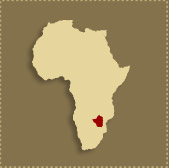Adventure Planner
Zimbabwe
THE COUNTRY
Although technically mopane forest of varying densities, the entire country of Zimbabwe, excluding cultivated land, is thornbush. The Lowveld to the southeast and the Zambezi Valley to the north are extremely thick thornbush, while the rolling Midlands and the Matetsi region are somewhat less dense.
Though subject to periodic drought, Zimbabwe is a well-watered country with numerous winding rivers offering lush habitat.
The road system throughout the country is excellent, second best on the continent only to South Africa.
GAME
Zimbabwe’s thornbush is ideal habitat for a wide variety of antelope species. Creation of edge habitat because of cultivation and permanent water sources because of cattle ranching has only increased concentrations of plains game. Zimbabwe has few rarities and no species that cannot be hunted elsewhere, but offers a varied game list including some of Africa’s most desirable species. Southern greater kudu are exceptionally common and are among the largest in Africa. Sable antelope are well distributed, more numerous than anywhere else in Africa and, in the northwest, of exceptional trophy quality. Common species, such as impala, warthog, reedbuck, and duiker, are abundant. Zimbabwe’s river systems have tremendous numbers of bushbuck – Limpopo to the south and Chobe to the north. Lion, crocodile, leopard, hippo, buffalo, and elephant are abundant in specific areas.
Waterbuck, eland, blue wildebeest, tsessebe, and nyala are spotty in distributio, but can be locally abundant if on your wish list.
Availability of prey plus the ideal thornbush habitat makes Zimbabwe excellent leopard country from top to bottom. At one time the whole country was also excellent lion and buffalo habitat, but here is where Zimbabwe diverges into two safaris within one country.
On the periphery – in the Wankie (now Hwange) Park corridor, the Zambezi Valley, and the Gona-Rhe-Zou – one finds Zimbabwe’s buffalo herds, the vast majority of lions, and almost all of her nearly 80,000 elephant. In these border regions, safaris are conducted on vast forestry concessions or tribal trust lands, and one can hunt lion, leopard, buffalo, and elephant with expectations of success. These areas have neither developed water sources nor edge habitat, so plains game, though present, are widely scattered.
In the center of the country, largely on private lands, one finds both great concentrations and great varieties of plains game. Leopard is common as well, but with few exceptions elephant, buffalo, and lion are long gone from the interior of the country.
This “ranch hunting” is generally done on very large estates, largely free of any game fencing, and offers successful hunting for an incredible variety of antelope. More traditional safaris in areas such as the Zambezi Valley will generally not yield a large bag of antelope, but are slanted toward some combination of elephant, lion, buffalo, and leopard. A change of areas is generally a must for an expanded bag.
HUNTING CONDITIONS
Because of the dense thornbush, much Zimbabwe hunting is done on foot. The more common species may be hunted by cruising with a vehicle until game is spotted, but buffalo and elephant, and often eland, sable, and kudu, will be hunted by tracking – always exciting and usually demanding.
The cats are hunted almost exclusively by baiting. Although leopards are very plentiful, remember that Zimbabwe’s leopards have been hunted for a century. It is always time-consuming to get a leopard, and is best done by really concentrating on Old Spots.
Camps vary immensely depending on the circumstances. On private lands, accommodations are usually guest quarters at the ranch headquarters. In remote areas such as the Zambezi Valley, tent camps or thatched huts on cement slabs tend to be well-supplied and, whatever the accommodations, very comfortable. Non-hunters are welcome!
The excellent road network, plus reasonably available internal commercial flights and fairly inexpensive charters, make it possible to combine several areas within even a fairly short safari. Since plains game is common on private land but buffalo are very scarce, it is common and practical to spend three or four days hunting buffalo in the Valley, then whisk off to a large ranch in the Midlands or Lowveld for a week or so of plains game hunting. However, combinations such as this make leopard hunting very difficult. If leopard is the primary goal, the best course is to plan for 14 days in one area, concentrating on leopard.



